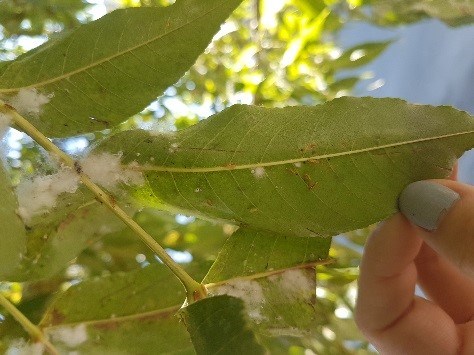Yellow sticky traps are hanging from some mancana ash trees downtown as the municipality monitors for the cottony ash psyllid, a bug that can damage leaves by sucking the juices out of them.
Main Street contains a large concentration of mancana ash trees, with about 50 to 60 lining the sidewalks, explained Sarah Regent, a parks department gardener. This is the first year the department has put out the traps, but it has been keeping an eye on the ash trees for the last couple of years.
The monitoring is going well, she said. The department is not seeing too many psyllids in the traps. Having the traps in place allows parks and rec to determine when the best time to spray the trees is.
Right now many trees in Moose Jaw are stressed, but particularly the ash tree breeds, Regent continued. This is due to the dry conditions during the last few years, along with several cold winters with little snow cover. The trees are also stressed since they are contained within sidewalk concrete cut-outs, which is a tough and unnatural environment for them to live.
“Those extra stressors have really taken a toll on it and we’ve seen the cottony ash psyllid attack them the last two years,” she said. “That also is quite a stressor. And high populations of cottony ash psyllid due cause a lot of dieback in … trees.”
The parks department has caught a few cottony ash psyllids in the traps, with the bugs found at the end of June and beginning of July. The goal is to catch them before they start laying eggs.
Once these bugs are in the trees, they begin to eat the leaves and suck out their liquids, Regent said. This can cause the leaves to turn brown and curl. This also affects the trees’ ability to photosynthesize energy and protect itself in the winter.
“They’re sucking energy out of it all season long, especially with this second generation that will be hatching pretty quickly here — this week and next week,” she continued. “And then later in the season, we’ll start seeing white cottony substances … that in itself is quite a nuisance because it does fall and it is very sticky.”
Reducing stresses on the tree is one way to prevent these bugs from harming trees. This includes watering trees and then spraying them if an infestation is present.
“This year doesn’t seem to be too bad (for infestations), but we are cautious and we are monitoring because it does have the potential to be quite devastating,” Regent added.
The parks department is also monitoring for the emerald ash borer beetle. The department has put out five traps around the municipality, particularly where this a high population of emerald ash trees and where out-of-province traffic is heavy.
This is the second year the parks department is monitoring for this particular bug, explained Regent. So far no bugs have been detected, which is good. They have not been detected in Saskatchewan yet, either; right now they are destroying emerald ash trees in Manitoba.
More information about the cottony ash psyllid or emerald ash borer can be found at moosejaw.ca.




